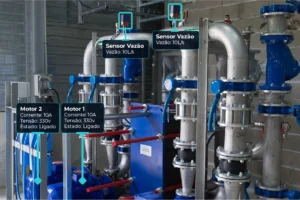Coletar dados de forma contínua não é mais uma barreira tecnológica. Atualmente, dispositivos IoT, sensores e sistemas para armazenamento de dados de forma organizada já são mais acessíveis para todos os tipos de indústria. Segundo o Portal da Indústria, 69% das indústrias brasileiras já utilizavam algum tipo de tecnologia IoT digital em 2022.
Além de atender às exigências legais, a implementação de um sistema de rastreabilidade também traz vantagens competitivas. Com ele, é possível garantir não só a qualidade do produto acabado, mas também ter mais controle sobre a necessidade de recalls em casos de defeitos causados por fatores externos e internos aos ambientes produtivos. Segundo o Ministério da Justiça, em 2017 o Brasil bateu recorde de recalls em produtos de consumo, sendo o setor automobilístico o líder de chamamentos.
Conectar essas tecnologias com a metodologia de rastreabilidade traz uma nova forma de visualização. Por exemplo, em uma produção de embutidos, onde é necessário utilizar um forno industrial, é comum possuir um relatório de cada fase do processo de cozimento, com dados como:
| Estágio | Lote 1 | Lote 2 |
| 1 | 25 °F | 30 °F |
| 2 | 45 °F | 45 °F |
| 3 | 60 °F | 61 °F |
| 4 | 139 °F | 139 °F |
| 5 | 154 °F | 154 °F |
| 6 | 168 °F | 170 °F |
| 7 | 50 °F | 60 °F |
| 8 | 30 °F | 25 °F |
Analisando essa informação de forma gráfica tem-se o seguinte comportamento:
Neste tipo de amostragem, várias informações importantes não são coletadas, o que pode levar a uma falsa sensação de que os valores de temperatura estão se comportando como esperado. Utilizando uma taxa de amostragem maior e um sistema de big data, é possível armazenar a curva completa de cozimento, por exemplo:
Neste exemplo, é possível encontrar possíveis desvios e comparar os lotes de forma muito mais precisa:
Além de poder armazenar muito mais dados hoje, também é possível coletar dados de várias outras fontes e equipamentos que no passado eram chamados de “black box”. Atualmente, esses equipamentos já se integram mais facilmente a uma estrutura de coleta de dados, permitindo correlacionar uma falha de uma máquina com a falha em outra. Por exemplo, é possível diagnosticar rapidamente uma pausa em uma linha de produção ocorrida poucos minutos depois de uma falha na sala de compressores.

Visualização Intuitiva: Melhorando a Rastreabilidade de Dados
A rastreabilidade de dados, além de facilitar o gerenciamento da produção e a correção de erros, ajuda a obter maior precisão na análise. Isso ocorre porque essa forma de visualizar dados permite a coleta de mais informações, melhorando a qualidade e diminuindo as limitações.
Visualizar e gerenciar uma grande quantidade de dados é um desafio que, com tecnologias modernas, se torna cada vez mais fácil. Com gráficos animados, é possível ganhar uma nova dimensão na análise, que antes ficava restrita a dois eixos (x, y). Agora, além disso, é possível representar o movimento das variáveis nesses eixos ao longo do tempo. Por exemplo, é possível fazer uma análise de torque (eixo y) e ângulo (eixo x) do aperto de mais de 13 mil parafusos. Esse movimento foi realizado ao longo de mais de 200 dias (animação) e pode ser monitorado, como demonstrado no gráfico abaixo:
Neste mesmo exemplo, é possível adicionar mais dados, como a temperatura ambiente do dia ou de algum sistema de medição próximo ao local do aperto. Esses dados poderiam ser representados pelo tamanho de cada círculo, trazendo ainda mais informações para serem exploradas:
Aumento de Performance a partir da Rastreabilidade de Dados
Ao utilizar tecnologias de conexão que permitem a coleta simplificada de dados, é possível obter insights que antes ficariam ocultos. Essa situação ocorre principalmente pela falta de dados, problema que a rastreabilidade resolve. Com essas ferramentas, as análises e decisões são feitas de maneira mais assertiva e concreta, sempre baseadas nas informações coletadas diretamente do maquinário.
Os responsáveis por esses insights são os profissionais de dados, que utilizam os dados coletados para trazer novas perspectivas para a indústria. Partindo da visão total do processo, os cientistas conseguem fazer suas análises com o objetivo de descobrir e explorar. Assim, é possível entender padrões, identificar tendências, assegurar ou melhorar a qualidade, reduzir danos e identificar falhas diretamente na fonte. A visibilidade proporcionada pela digitalização resulta na redefinição de estratégias e na implementação de melhorias.
Ter um histórico de dados também contribui para esse cenário, principalmente através de ações que aumentam a produtividade. Segundo a CNI (Confederação Nacional da Indústria), esse índice cresceu 0,7% no terceiro trimestre de 2023. Isso reforça que a implementação de soluções tecnológicas ajuda a desbloquear resultados e elevar a indústria para um novo patamar de produtividade.